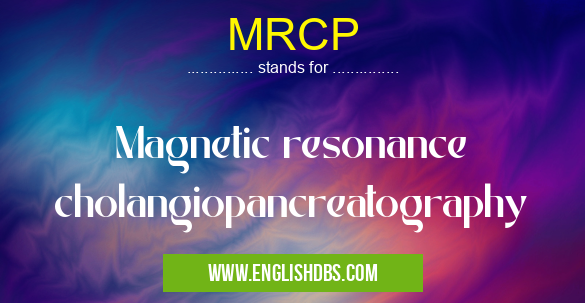What does MRCP mean in HOSPITALS
Magnetic resonance cholangiopancreatography (MRCP) is a medical imaging technique that uses magnetic resonance imaging (MRI) to visualize the biliary tree and pancreatic duct. It is a non-invasive procedure that does not require the use of radiation or contrast agents. MRCP is used to diagnose and evaluate a variety of conditions affecting the biliary tree and pancreas, including:

MRCP meaning in Hospitals in Medical
MRCP mostly used in an acronym Hospitals in Category Medical that means Magnetic resonance cholangiopancreatography
Shorthand: MRCP,
Full Form: Magnetic resonance cholangiopancreatography
For more information of "Magnetic resonance cholangiopancreatography", see the section below.
- Choledocholithiasis (gallstones in the bile duct)
- Cholecystitis (inflammation of the gallbladder)
- Pancreatitis (inflammation of the pancreas)
- Biliary atresia (a congenital condition in which the bile ducts are absent or blocked)
- Pancreatic cancer
Procedure
MRCP is performed using a MRI scanner. The patient lies on a table that is moved into the scanner. The scanner produces a strong magnetic field and radio waves that cause the atoms in the body to align. The scanner then detects the signals emitted by the atoms and uses this information to create images of the body.
Benefits
MRCP is a safe and effective procedure with few side effects. It is a non-invasive alternative to endoscopic retrograde cholangiopancreatography (ERCP), which is a more invasive procedure that involves passing a small camera through the mouth and into the bile duct and pancreatic duct. MRCP is also more accurate than ERCP in diagnosing some conditions, such as choledocholithiasis.
Essential Questions and Answers on Magnetic resonance cholangiopancreatography in "MEDICAL»HOSP"
What is MRCP?
Magnetic resonance cholangiopancreatography (MRCP) is a non-invasive medical imaging technique that uses magnetic resonance imaging (MRI) to visualize the bile ducts and pancreatic ducts.
What are the benefits of MRCP compared to other imaging techniques?
MRCP offers several benefits over other imaging techniques, including:
- No ionizing radiation exposure
- High-resolution images of the bile ducts and pancreatic ducts
- Ability to detect small abnormalities that may not be visible on other imaging tests
What can MRCP be used to diagnose?
MRCP can be used to diagnose a variety of conditions affecting the bile ducts and pancreatic ducts, including:
- Gallstones
- Cholangitis
- Pancreatitis
- Bile duct tumors
- Pancreatic tumors
How is MRCP performed?
MRCP is typically performed as an outpatient procedure. The patient lies on a table that slides into an MRI machine. A contrast agent may be injected into a vein to enhance the visibility of the bile ducts and pancreatic ducts. The MRI scan usually takes about 30-60 minutes.
Are there any risks associated with MRCP?
MRCP is generally a safe procedure with few risks. However, possible risks include:
- Allergic reaction to the contrast agent
- Kidney damage if the patient has impaired kidney function
- Claustrophobia if the patient is confined to the MRI machine
Final Words: MRCP is a valuable imaging technique for diagnosing and evaluating conditions affecting the biliary tree and pancreas. It is a safe and effective procedure with few side effects.
